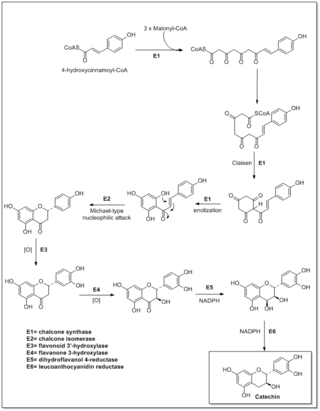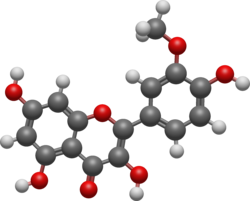
Quercetin is a plant flavonol from the flavonoid group of polyphenols. It is found in many fruits, vegetables, leaves, seeds, and grains; capers, red onions, and kale are common foods containing appreciable amounts of it. It has a bitter flavor and is used as an ingredient in dietary supplements, beverages, and foods.

Opuntia ficus-indica, the Indian fig opuntia, fig opuntia, or prickly pear, is a species of cactus that has long been a domesticated crop plant grown in agricultural economies throughout arid and semiarid parts of the world. O. ficus-indica is the most widespread and most commercially important cactus. It is grown primarily as a fruit crop, and also for the vegetable nopales and other uses. Cacti are good crops for dry areas because they efficiently convert water into biomass. O. ficus-indica, as the most widespread of the long-domesticated cactuses, is as economically important as maize and blue agave in Mexico. Opuntia species hybridize easily, but the wild origin of O. ficus-indica is likely to have been in central Mexico, where its closest genetic relatives are found.

Rutin is the glycoside combining the flavonol quercetin and the disaccharide rutinose. It is a flavonoid glycoside found in a wide variety of plants, including citrus.

Tagetes lucida is a perennial plant native to Mexico and Central America. It is used as a medicinal plant and as a culinary herb. The leaves have a tarragon-like scent, with hints of anise, and it has entered the nursery trade in North America as a tarragon substitute. Common names include sweetscented marigold, Mexican marigold, Mexican mint marigold, Mexican tarragon, sweet mace, Texas tarragon, pericón, yerbaniz, and hierbanís.
In enzymology, a 3,7-dimethylquercetin 4'-O-methyltransferase is an enzyme that catalyzes the chemical reaction
In enzymology, a 3-methylquercetin 7-O-methyltransferase is an enzyme that catalyzes the chemical reaction
In enzymology, an apigenin 4'-O-methyltransferase is an enzyme that catalyzes the chemical reaction
In enzymology, a hexaprenyldihydroxybenzoate methyltransferase is an enzyme that catalyzes the chemical reaction
In enzymology, an inositol 3-methyltransferase is an enzyme that catalyzes the chemical reaction
In enzymology, an isoflavone 7-O-methyltransferase is an enzyme that catalyzes the chemical reaction
In enzymology, an isoorientin 3'-O-methyltransferase is an enzyme that catalyzes the chemical reaction
In enzymology, a kaempferol 4'-O-methyltransferase is an enzyme that catalyzes the chemical reaction
In enzymology, a luteolin O-methyltransferase is an enzyme that catalyzes the chemical reaction
In enzymology, a macrocin O-methyltransferase is an enzyme that catalyzes the chemical reaction
In enzymology, a quercetin 3-O-methyltransferase is an enzyme that catalyzes the chemical reaction

Flavonoids are synthesized by the phenylpropanoid metabolic pathway in which the amino acid phenylalanine is used to produce 4-coumaroyl-CoA. This can be combined with malonyl-CoA to yield the true backbone of flavonoids, a group of compounds called chalcones, which contain two phenyl rings. Conjugate ring-closure of chalcones results in the familiar form of flavonoids, the three-ringed structure of a flavone. The metabolic pathway continues through a series of enzymatic modifications to yield flavanones → dihydroflavonols → anthocyanins. Along this pathway, many products can be formed, including the flavonols, flavan-3-ols, proanthocyanidins (tannins) and a host of other various polyphenolics.

Petunidin (Pt), like Europinidin and Malvidin, is derived from Delphinidin and is an O-methylated anthocyanidin of the 3-hydroxy type. It is a natural organic compound, a dark-red or purple water-soluble pigment found in many redberries including chokeberries, Saskatoon berries or different species of grape, and also part of the pigments responsible for the petal colors in many flowers. This pigment gives the Indigo Rose tomatoes the majority of their deep purple color when the fruits are exposed to sunlight. The name of the molecule itself is derived from the word Petunia.
The O-methylated flavonoids or methoxyflavonoids are flavonoids with methylations on hydroxyl groups. O-methylation has an effect on the solubility of flavonoids.

Ayanin is an O-methylated flavonol, a type of flavonoid. It is the 3,7,4'-tri-O-methylated derivative of quercetin.

Acacetin is a 4′-O-methylated flavone of the parent compound apigenin, found in Robinia pseudoacacia, Turnera diffusa (damiana), shows moderate aromatase inhibition, Betula pendula, and in the fern Asplenium normale.









